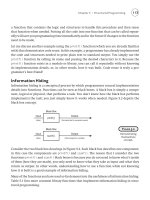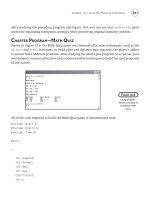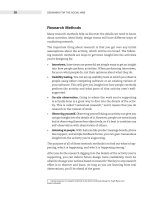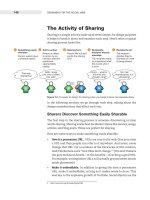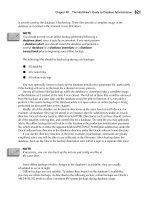Programming Groovy dynamic productivity for the java developer phần 9 potx
Bạn đang xem bản rút gọn của tài liệu. Xem và tải ngay bản đầy đủ của tài liệu tại đây (183.43 KB, 31 trang )
MOCKING USING EXPANDOMETACLASS 249
The output from the previous bit of code is a reassuring pass of the
test, as shown here:
.
Time: 0.027
OK (1 test)
Categories are useful only with Groovy code. It does not help to mock
methods called from with i n compiled Java code.
The overriding approach you saw in Section 16.5, Mocking by Overrid-
ing, on page
244 is useful for both Java and Groovy code. However, the
overriding approach can’t be used if the class being tested is final. The
categories approach shines in this case.
16.7 Mocking Using ExpandoMetaClass
Another way to intercept method calls i n Groovy is to use the Expando-
MetaClass (cf. Section
14.2, Injecting Methods Using ExpandoMetaClass,
on page 208 and Section 14.3, Injecting Methods into Specific Instances,
on page 212). You don’t have to create a separate class as in the two
approaches you’ve seen so far. Instead, creat e a closure for each method
you want to mock, and set that into MetaClass for the instance being
tested. Let’s take a look at an example.
Create a separate inst ance of ExpandoMetaClass for the instance being
tested. This MetaClass will carry the mock implementation of collabora-
tor methods.
In this example, shown in the following code, you create a closure for
mocking println( ) and set that into an instance of ExpandoMetaClass for
ClassWithHeavierDependencies in line number 9. Similarly, you create a
closure for mocking someAction( ) in line number 10. The advantage of
creating an instance of ExpandoMetaClass specifically for the instance
under test is that you don’t globally affect the metaclass for CodeWith-
HeavierDependencies. So, if you have other tests, the method you mock
does not affect them (r emember to keep the tests isolated from each
other).
MOCKING USING EXPANDOMETACLASS 250
Download UnitTestingWithGroovy/TestUsingExpandoMetaClass.groovy
Line 1
import com.agiledeveloper.CodeWithHeavierDependencies
-
-
class TestUsingExpandoMetaClass extends GroovyTestCase
-
{
5
void testMyMethod()
-
{
-
def result
-
def emc = new ExpandoMetaClass(CodeWithHeavierDependencies)
-
emc.println = { text -> result = text }
10
emc.someAction = { -> 25 }
-
emc.initialize()
-
-
def testObj = new CodeWithHeavierDependencies()
-
testObj.metaClass = emc
15
-
testObj.myMethod()
-
-
assertEquals 35, result
-
}
20
}
The output from the previous code again confirms that the test passes:
.
Time: 0.031
OK (1 test)
In this example, when myMethod( ) calls the two methods—println( ) and
someAction( )—the ExpandoMetaClass intercepts those calls and routes
them to your mock implementation. Again, this is similar to the advice
on AOP.
Compared to the previous two approaches, creating the mock, sett i ng
up its expectations, and using it in the test are ni cely contained within
the test method in this case. There are no additional classes to create.
If you have other tests, you can create the mocks necessary to satisfy
those tests in a concise way.
This approach of using Exp andoMetaClass for mocking is useful only
with Groovy code. It does not help to mock methods called from within
precompiled Java code.
MOCKING USING EXPANDO 251
16.8 Mocking Using Expando
So far in this chapter you looked at ways to mock instance met hods
called from within another instance method. In the rest of th i s chapter,
you’ll look at ways to mock other objects on which your code depends.
Let’s take a look at an example. Suppose the methods of a class you’re
interested in testing depend on a File. That’ll make it hard to write a
unit test. So, you need to find ways to mock this object so your unit
tests on your class can be quick and automated:
Download UnitTestingWithGroovy/com/agiledeveloper/ClassWithDependency.groovy
package com.agiledeveloper
public class ClassWithDependency
{
def methodA(val, file)
{
file.write
"The value is ${val}."
}
def methodB(val)
{
def file = new java.io.FileWriter(
"output.txt"
)
file.write
"The value is ${val}."
}
def methodC(val)
{
def file = new java.io.FileWriter(
"output.txt"
)
file.write
"The value is ${val}."
file.close()
}
}
In this code, you have three methods with different flavors of dependen-
cies. me thodA( ) receives an instance of what appears to be a File. The
other two methods, methodB( ) and methodC( ), instanti ate an instance
of FileWriter internally. The Expando class will help you with the first
method only. So, consider only methodA( ) in this section. We’ll see
how to test the other two met hods in Section
16.10, Mocking Using
the Groovy Mock Library, on page 254.
methodA( ) writes a message to the given File object using its write( )
method. Your goal is to test methodA( ), but without actually having
to write to a physical file and then reading its contents back to assert.
MOCKING USING EXPANDO 252
You can take advantage of Gr oovy’s dynamic t yping here because
methodA( ) does not specify the type of its parameter. So, you can send
any object that can fulfill its capability, such as the write( ) method (see
Section
4.4, Design by C apability, on page 80). Let’s do that now. Cre-
ate a class HandTossedFileMock with the write( ) method. You don’t have
to worry about all the properties and methods that the real File class
has. All you care about is what the method being tested really calls.
The code is as follows:
Download UnitTestingWithGroovy/TestUsingAHandTossedMock.groovy
import com.agiledeveloper.ClassWithDependency
class TestWithExpando extends GroovyTestCase
{
void testMethodA()
{
def testObj = new ClassWithDependency()
def fileMock = new HandTossedFileMock()
testObj.methodA(1, fileMock)
assertEquals
"The value is 1."
, fileMock.result
}
}
class HandTossedFileMock
{
def result
def write(value) { result = value }
}
The output from the previous code confirms a passing test:
.
Time: 0.015
OK (1 test)
In this code, the mock implementation of write( ) that you created within
HandTossedFileMock simply saves the parameter it r eceives into a result
property. You’re sending an instance of this mock class to methodA( )
instead of the real File. methodA( ) is quite happy to use the mock, thanks
to dynamic typing.
That was not too bad; however, it would be gr eat if you did not have
to hand-toss that separate class. This is where Expando comes in (see
Section 15.1, Creating Dynamic Classes with Expando, on page 224).
MOCKING USING MAP 253
Simply tell an instance of Expando to hold a property called text and a
mock implementation of the write( ) method. Then pass this instance to
methodA( ). Let’s look at the code:
Download UnitTestingWithGroovy/TestUsingExpando.groovy
import com.agiledeveloper.ClassWithDependency
class TestUsingExpando extends GroovyTestCase
{
void testMethodA()
{
def fileMock = new Expando(text:
''
, write: { text = it })
def testObj = new ClassWithDependency()
testObj.methodA(1, fileMock)
assertEquals
"The value is 1."
, fileMock.text
}
}
The output is as follows:
.
Time: 0.022
OK (1 test)
In both the previous examples, no real physical file was created when
you called methodA( ). The unit test runs fast, and you don’t have any
files to read or clean up after the test.
Expando is useful w hen you pass t he dependent object to the method
being t est ed. If, on the other hand, the method is creating the depen-
dent object internally (such as the methods methodB( ) and methodC( )),
it is of no help. We’ll address this in Section
16.10, Mocking Using the
Groovy Mock Library, on the next page.
16.9 Mocking Using Map
You saw an example of using Expando as a mock object. You can also
use a Ma p . A map, as you know, has keys and associated values. The
values can be eit her objects or even closures. You can take advantage
of t his to use a Map in place of a collaborator.
MOCKING USING THE GROOVY MOCK LIBRARY 254
Here’s a rewrite of the example using Expando from Section 16.8, Mock-
ing Using Expando, on page 251, this time using a Map:
Download UnitTestingWithGroovy/TestUsingMap.groovy
import com.agiledeveloper.ClassWithDependency
class TestUsingMap extends GroovyTestCase
{
void testMethodA()
{
def text =
''
def fileMock = [write : { text = it }]
def testObj = new ClassWithDependency()
testObj.methodA(1, fileMock)
assertEquals
"The value is 1."
, text
}
}
The output is as follows:
.
Time: 0.029
OK (1 test)
Just like Expando, the Map is useful when you pass the dependent
object to the method being tested. It does not help if the collabora-
tor is created internally in the method being tested. We’ll address this
case next.
16.10 Mocking Using the Groovy Mock Library
Groovy’s mock library implemented in the groovy.mock.interceptor pack-
age is useful to mock deeper dependencies, that is, instances of collab-
orators/dependent objects created within th e methods you’re testing.
StubFor and MockFor are two classes that take care of this. Let’s look at
them one at a time.
StubFor and MockFor are intended to intercept calls to methods like cat-
egories do (see Section
16.6, Mocking Using Categories, on page 248).
However, unlike categories, you don’t have to create separate classes
for mocking. Introduce the mock methods on instances of StubFor or
MockFor, and these classes take care of replacing the MetaClass for the
object you’re mocking.
MOCKING USING THE GROOVY MOCK LIBRARY 255
In the sidebar on page 243, I discussed the difference between stubs
and mocks. Let’s star t with an example using StubFor t o understand
the strengths and weaknesses of stubs. Then we’ll take a look at the
advantage mocks offer by using MockFor.
Using StubFor
Let’s use Groovy’s StubFor to create stubs for the File class:
Download UnitTestingWithGroovy/TestUsingStubFor.groovy
Line 1
import com.agiledeveloper.ClassWithDependency
-
-
class TestUsingStubFor extends GroovyTestCase
-
{
5
void testMethodB()
-
{
-
def testObj = new ClassWithDependency()
-
-
def fileMock = new groovy.mock.interceptor.StubFor(java.io.FileWriter)
10
def text
-
fileMock.demand.write { text = it.toString() }
-
fileMock.demand.close {}
-
-
fileMock.use
15
{
-
testObj.methodB(1)
-
}
-
-
assertEquals
"The value is 1."
, text
20
}
-
}
When creating an instance of StubFor, you provided the class you’re
interested in stubbing, in this case the java.io.FileWriter. You then created
a closure for the stub implementation of the write( ) meth od. On line
number 14, you called the use( ) method on the stub. At this time, it
replaces the MetaClass of FileWriter wi th a ProxyMetaClass. Any call to an
instance of FileWriter from within the attached closure will be routed to
the stub.
Stubs and mocks, however, do not help intercept calls to constructors.
So, in the previous example, the constructor of FileWriter is called, and
it ends up creating a file named output.txt on th e disk.
StubFor helped you test whether y our method, methodB( ), is cr eat i ng
and writing the expected content to it. However, it has one limitati on. It
failed to test whether the method was well behaved by closing the file.
Even though you demanded the close( ) method on the stub, it ignored
checking whether close( ) was actually called. The stub simply stands in
MOCKING USING THE GROOVY MOCK LIBRARY 256
for the collaborator and verifies the state. To verif y behavior, you have
to use a mock (see the sidebar on page 243), specifically, the MockFor
class.
Using MockFor
Let’s take the previous test code and make one change to it:
Download UnitTestingWithGroovy/TestUsingMockFor.groovy
//def fileMock = new groovy.mock.interceptor.StubFor(java.io.FileWriter)
def fileMock = new groovy.mock.interceptor.MockFor(java.io.FileWriter)
You replaced StubFor with MockFor—that’s the only change. When you
run the test now, it fails, as shown here:
.F
Time: 0.093
There was 1 failure:
1) testMethod1(TestUsingStubFor)junit.framework.AssertionFailedError:
verify[1]: expected 1 1 call(s) to
'close'
but was never called.
Unlike the stub, the mock tells you that even though your code pro-
duced the desired result, it did not behave as expected. That is, it did
not call the close( ) method t hat was set up in the expectation using
demand.
methodC( ) does the same thing as methodB( ), but it calls close( ). Let’s
test that method using M o ckFor:
Download UnitTestingWithGroovy/TestMethodCUsingMock.groovy
import com.agiledeveloper.ClassWithDependency
class TestMethodCUsingMock extends GroovyTestCase
{
void testMethodC()
{
def testObj = new ClassWithDependency()
def fileMock = new groovy.mock.interceptor.MockFor(java.io.FileWriter)
def text
fileMock.demand.write { text = it.toString() }
fileMock.demand.close {}
fileMock.use
{
testObj.methodC(1)
}
assertEquals
"The value is 1."
, text
}
}
MOCKING USING THE GROOVY MOCK LIBRARY 257
In this case, the mock tells y ou that it is quite happy with the collabo-
ration. The test passes, as shown here:
.
Time: 0.088
OK (1 test)
In the previous examples, the method under test cr eat ed only one in-
stance of the object being mocked—FileWriter. What if the method cre-
ates more than one of these objects? The mock represents all of these
objects, and you have to create the demands for each of them. Let’s look
at an example of using two instances of FileWriter. The useFiles( ) method
in t he following code copies the g i ven parameter to the first file and
writes t he size of the parameter to the second:
class TwoFileUser
{
def useFiles(str)
{
def file1 = new java.io.FileWriter(
"output1.txt"
)
def file2 = new java.io.FileWriter(
"output2.txt"
)
file1.write str
file2.write str.size()
file1.close()
file2.close()
}
}
Here’s the t est for that code:
Download UnitTestingWithGroovy/TwoFileUserTest.groovy
class TwoFileUserTest extends GroovyTestCase
{
void testUseFiles()
{
def testObj = new TwoFileUser()
def testData =
'Multi Files'
def fileMock = new groovy.mock.interceptor.MockFor(java.io.FileWriter)
fileMock.demand.write() { assertEquals testData, it }
fileMock.demand.write() { assertEquals testData.size(), it }
fileMock.demand.close(2 2) {}
fileMock.use
{
testObj.useFiles(testData)
}
}
}
MOCKING USING THE GROOVY MOCK LIBRARY 258
The output from running the previous test is as follows:
Download UnitTestingWithGroovy/TwoFileUserTest.output
.
Time: 0.091
OK (1 test)
The demands you created are to be satisfied collectively by both the
objects created in the method being tested. The mock is quite flexible
to support more than one object. Of course, if you have a lots of objects
being created, it can get hard to implement. The ability to specify mul-
tiplicity of calls, discussed next, may help in that case.
The mock keeps track of the sequence and number of calls to a method,
and if the code being tested does not exactly behave like the expectation
you have demanded, the mock raises an exception, failing the test.
If you have to set up expectations for multiple calls to the same method,
you can do that easily. Here is an example:
def someWriter()
{
def file = new FileWriter(
'output.txt'
)
file.write(
"one"
)
file.write(
"two"
)
file.write(3)
file.flush()
file.write(file.getEncoding())
file.close()
}
Suppose you care only to test the interact i on between your code and
the collaborator. The expectation you need to set up is for three calls to
write( ), followed by a call to flush( ), a call to getEncoding( ), then a call to
write( ), and finally a call to close( ).
You can specify the cardinality or multiplicity of a call easily using a
range with demand. For example, mock.demand.write(2 4) { } says that
you expect the method write( ) to be called at least two times, but no
more than four times. Let’s write a test for the previous method to see
how easy i t is to express the expectations for multiple calls and the
return values and also assert that the parameter values received are
expected.
MOCKING USING THE GROOVY MOCK LIBRARY 259
void testSomeWriter()
{
def fileMock = new groovy.mock.interceptor.MockFor(java.io.FileWriter)
fileMock.demand.write(3 3) {}
// If you want to say upto 3 times, use 0 3
fileMock.demand.flush {}
fileMock.demand.getEncoding { return
"whatever"
} // return is optional
fileMock.demand.write { assertEquals
'whatever'
, it.toString() }
fileMock.demand.close {}
fileMock.use
{
testObj.someWriter()
}
}
In this example, the mock asserts t hat write( ) was called three times;
however, it failed to assert the parameters passed in. You can modify
the code to assert for parameters, as shown here:
def params = [
'one'
,
'two'
, 3]
def index = 0
fileMock.demand.write(3 3) { assert it == params[index++] }
// If you want to say upto 3 times, use 0 3
Unit test i ng takes quite a bit of discipline. However, the benefits out-
weigh the cost. Unit testing is cri tical in dynamic languages that offer
greater flexibility.
In this chapter, I presented techniques for managing dependencies via
stubs and mocks. You can use Groovy to unit test y our Java code. You
can use your existing unit testing and mock frameworks. You can also
override methods to mock your Groovy and Java code. To unit test your
Groovy code, you can use categories and ExpandoMetaClass. Both let
you mock by intercepting method calls. ExpandoMetaClass give you the
added advantages that you don’t have to create extra classes and that
your test is concise. For simple mocking of parameter objects, use Maps
or Expando. If you want to set up expectations for multi ple methods
and mock dependencies that are internal to methods being tested, use
StubFor. To test the state as well as the behavior, use MockFor.
You saw h ow the dynamic nature of Groovy along with its metapr o-
gramming capability makes unit testing a breeze. As you evolve your
code, refactor it, and get a better understanding of your application
requirements, unit testing with Groovy can help maintain your velocity
of development. It’ll give you confidence that your application is con-
tinuing to meet your expectations—use it as a carabiner as you ascend
through your application development complexities.
Chapter
17
Groovy Builders
Builders are internal DSLs that provide ease in working with certain
types of problems. For instance, if you have a need to work with nested,
hierarchical structures, such as tree structures, XML representations,
or HTML representations, you’ll find builders to be very useful. Basi-
cally, builders provide syntax that does not tie you closely with the
underlying structure or implementation. They are facades because they
don’t replace the underlying implementation; instead, they provide an
elegant way to work with it.
Groovy provides builders for a number of everyday tasks, including
working with XML, HTML, DOM, SAX, Swing, and even Ant. In this
chapter, you’ll take a look at two of them—XML MarkupBuilder and Swing-
Builder—to get a flavor of the builders. You’ll then explore two techni ques
to create your own builders.
17.1 Building XML
Most of us love to hate XML. Working with XML gets harder as the
document size gets larger, and also the tools and API support are not
pleasant. I have this theory about XML that it’s like humans. It starts
out cute when it’s small and gets annoying when it becomes bigger.
XML may be a fine format for machines to handle, but it’s rather un-
wieldy to work with directly. Basically, no one really wants to work with
XML, but you’re often forced to do so. Groovy alleviates this a great deal
by making working with XML almost fun.
BUILDING XML 261
Let’s take a look at an example of one way to create XML documents in
Groovy—using a builder:
Download UsingBuilders/UsingXMLB uilder.groovy
bldr = new groovy.xml.MarkupBuilder()
bldr.languages {
language(name:
'C++'
) { author(
'Stroustrup'
)}
language(name:
'Java'
) { author(
'Gosling'
)}
language(name:
'Lisp'
) { author(
'McCarthy'
)}
}
This code uses the groovy.xml.MarkupBuilder to create an XML document.
When you call arbitrary methods or properties on the builder, it kindly
assumes that you’re referring to either an element name or an attribute
name in the resulting XML document depending on t he context of the
call. Here’s the output from the previous code:
<languages>
<language name=
'C++'
>
<author>Stroustrup</author>
</language>
<language name=
'Java'
>
<author>Gosling</author>
</language>
<language name=
'Lisp'
>
<author>McCarthy</author>
</language>
</languages>
You called a method named languages( ) that does not exist on the
instance of the MarkupBuilder class. Instead of rejecting you, the builder
smartly assumed your call meant to define a root element of your XML
document, which is a rather nice assumption.
The closure attached to that method call now provides an internal con-
text. DSLs are context sensitive. Any nonexistent method called within
that closure is assumed to be a child element name. If you pass Map
parameters to the method calls (such as language(name: value)), they’re
treated as attributes of the elements. Any single parameter value (such
as author(value)) indicates element content instead of attributes. You
can study the previous code and the related output to see how the
MarkupBuilder inferred the code.
In the previous example, I hard-coded the data that I wanted to go into
my XML document, and also the builder wrote to the standard output.
BUILDING XML 262
In a real project, neither of those conditions may be usual. I w ant data
to come from a collection that can be populated from a data source
or input stream. Also, I want to write out to a Writer inst ead of to the
standard output.
The builder can readily attach to a Writer that it can take as a construc-
tor argument. S o, let’s attach a StringWriter to the builder. Let the data
for the document come from a map.
1
Here’s an example that takes data
from a map, creates an XML document, and writes that into a String-
Writer:
Download UsingBuilders/BuildXML.g roovy
langs = [
'C++'
:
'Stroustrup'
,
'Java'
:
'Gosling'
,
'Lisp'
:
'McCarthy'
]
writer =
new StringWriter()
bldr =
new groovy.xml.MarkupBuilder(writer)
bldr.languages {
langs.each { key, value ->
language(name: key) {
author (value)
}
}
}
println writer
The output from the previous code is as follows:
<languages>
<language name=
'C++'
>
<author>Stroustrup</author>
</language>
<language name=
'Java'
>
<author>Gosling</author>
</language>
<language name=
'Lisp'
>
<author>McCarthy</author>
</language>
</languages>
The MarkupBuilder is quite adequate for small to medium documents.
However, if your document is large (a few megabytes), you can use
StreamingMarkupBuilder, which is kinder in memory usage. Let’s rewrite
1. The data may come from arbitrary source, for example, from a database. See Sec-
tion 10.2, Database Select, on page 166.
BUILDING XML 263
the previous example using the StreamingMarkupBuilder, but to add some
flavor, let’s also include namespaces and XML comments:
Download UsingBuilders/BuildUsingS t r eamingBuilder.groovy
langs = [
'C++'
:
'Stroustrup'
,
'Java'
:
'Gosling'
,
'Lisp'
:
'McCarthy'
]
xmlDocument =
new groovy.xml.StreamingMarkupBuilder().bind {
mkp.xmlDeclaration()
mkp.declareNamespace(computer:
"Computer"
)
languages {
comment <<
"Created using StreamingMarkupBuilder"
langs.each { key, value ->
computer.language(name: key) {
author (value)
}
}
}
}
println xmlDocument
The output from the previous code is as follows:
<?xml version=
"1.0"
?>
<languages xmlns:computer=
'Computer'
>
<! Created using StreamingMarkupBuilder >
<computer:language name=
'C++'
>
<author>Stroustrup</author>
</computer:language>
<computer:language name=
'Java'
>
<author>Gosling</author>
</computer:language>
<computer:language name=
'Lisp'
>
<author>McCarthy</author>
</computer:language>
</languages>
Using StreamingMark upBuilder, you can declar e namespaces, XML com-
ments, and so on, using the builder support property mkp. Once you
define a namespace, to associate an element with a namespace you
can use the dot notation on t he prefix, such as computer.language where
computer is a prefix.
The builders for XML make the syntax easy and elegant. You don’t have
to deal with the pointy syntax of X ML to create XML documents.
BUILDING SWING 264
17.2 Building Swing
The elegance of the builders concept is not restricted to XML structure.
Groovy provides a builder for creating Swing applications as well. When
working with Swing, you need to perform some mundane tasks such as
creating components (like buttons), r egi stering event handlers, and so
on. Typically to implement an event handler, you write an anonymous
inner class and in the implementation handler methods receive param-
eters (such as ActionEvent) even if you don’t care for th em. SwingBuilder
along with Groovy closures elimi nates the drudgery.
You can use the nested or hierarchical structur e provided by the builder
to create a container (such as JFrame) and its components (such as but-
tons, textboxes, and so on). Initialize components by using Groovy’s
flexible name-value pair initializat i on facility . Defining an event han-
dler is trivial. Simply provide it a closure. You’re building the familiar
Swing application, but you wil l find the code size is smaller. This helps
you quickly make changes, experiment, and g et feedback. You’re still
using the underlying Swing API, but the syntax is a lot different. You’re
using the Groovy idioms
2
to talk to Swing. Now, let’s create a Swing
application using the SwingBuilder class:
Download UsingBuilders/BuildSwing. groovy
bldr = new groovy.swing.SwingBuilder()
frame = bldr.frame(
title:
'Swing'
,
size: [50, 100],
layout: new java.awt.FlowLayout(),
defaultCloseOperation:javax.swing.WindowConstants.EXIT_ON_CLOSE
) {
lbl = label(text:
'test'
)
btn = button(text:
'Click me'
, actionPerformed: {
btn.text =
'Clicked'
lbl.text =
"Groovy!"
} )
}
frame.show()
The output from the previous code is shown in Figure 17.1, on the next
page.
2. See my blog about la nguages and idioms at />CUSTOM BUILDER USING METAPROGRAMMING 265
Figure 17.1: A little Swing application created using SwingBuilder
You initialized an instance of JFrame and assigned its title, size, and lay-
out, and you also set the default close operation, all in one simple state-
ment. This is equivalent to five separate statements in Java. Also, reg-
istering the event handler was as simple as providing a closure to the
actionPerformed property of button (for JButton). This eliminated the eff ort
in Java to create an anonymous inner class and implement the action-
Performed( ) method with th e ActionEvent parameter. Sure, there w as a
lot of syntax sugar, but the elegance and reduced code size makes it
easier t o work with the Swing API.
You l ooked at SwingBuilder, which is a facade that brings Groovy ele-
gance and ease to building Swing applications. Similarly, SwingXBuilder
(see
is a facade for the SwingX
UI library (for the Swi ngLabs extensions to the Swing library , see
http://
swingx.dev.java.net). If you use JIDE ( you can
use the JideBuilder (http:/ /groovy.codehaus.org/JideBuilder) i n Groovy.
Groovy’s GraphicsBuilder (
/>provides a Groovy w ay of building JavaFX-type Java2D Graphics.
17.3 Custom Builder Using Metaprogramming
As I discussed ear l i er, builders provide you with a way to create an
internal DSL for specialized complex tasks that use nested or hierar-
chical structure or format. When working with a specialized task in
your application, explore to see whether a builder exists that can solve
the problem. If you don’t find any builders, you can creat e your own.
CUSTOM BUILDER USING METAPROGRAMMING 266
You can create a custom builder in two ways. You can take up the entire
effort on y our shoulders by using the met aprogramming capabilities of
Groovy, as you’ll see in this section. Alter nately, you can use the Builder-
Support (Secti on
17.4, U sing BuilderSupport, on page 268) or Factory-
BuilderSupport (Section 17.5, Using FactoryBuilderSupport, on page 272)
already provided i n Groovy.
You’ll create a builder that builds a to-do list. Here’s the code t hat’s
using the builder you will create:
Download UsingBuilders/UsingTodoBuilder.groovy
bldr = new TodoBuilder()
bldr.build {
Prepare_Vacation (start:
'02/15'
, end:
'02/22'
) {
Reserve_Flight (on:
'01/01'
, status:
'done'
)
Reserve_Hotel(on:
'01/02'
)
Reserve_Car(on:
'01/02'
)
}
Buy_New_Mac {
Install_QuickSilver
Install_TextMate
Install_Groovy {
Run_all_tests
}
}
}
The output of running the previous code (once you create the ToDo-
Builder) is as follows:
To-Do:
- Prepare Vacation [start: 02/15 end: 02/22]
x Reserve Flight [on: 01/01]
- Reserve Hotel [on: 01/02]
- Reserve Car [on: 01/02]
- Buy New Mac
- Install QuickSilver
- Install TextMate
- Install Groovy
- Run all tests
Completed tasks are mar ked with a x. Nesting of tasks i s shown by
indentation, and task parameters such as start date are shown next to
their names.
In the previous DSL for the to-do list, you have created item n ames
such as “Reserve Car” using an underscore instead of space so you can
fit them as method names in Gr oovy. The only known method is build( ).
CUSTOM BUILDER USING METAPROGRAMMING 267
The rest—methods and properties—are handled using methodMissing( )
and propertyMissing( ), as shown next.
The result is mostly standard straightforward Groovy code with a good
use of metaprogramming. When a nonexistent method or property is
called, you assume it’s an item. You check whether a closure is attached
by test i ng the last parameter in args, obtained using the index -1. You
then set the delegate of the presented closure to the builder and invoke
the closure to traverse down the nested tasks.
Download UsingBuilders/TodoBuilder.groovy
class TodoBuilder
{
def level = 0
def result = new StringWriter()
def build(closure)
{
result <<
"To-Do:\n"
closure.delegate = this
closure()
println result
}
def methodMissing(String name, args)
{
handle(name, args)
}
def propertyMissing(String name)
{
Object[] emptyArray = []
handle(name, emptyArray)
}
def handle(String name, args)
{
level++
level.times { result <<
" "
}
result << placeXifStatusDone(args)
result << name.replaceAll(
"_"
,
" "
)
result << printParameters(args)
result <<
"\n"
if (args.length > 0 && args[-1] instanceof Closure)
{
def theClosure = args[-1]
theClosure.delegate =
this
theClosure()
}
USING BUIL DERSUPPOR T 268
level
}
def placeXifStatusDone(args)
{
args.length > 0 && args[0] instanceof Map &&
args[0][
'status'
] ==
'done'
?
"x "
:
"- "
}
def printParameters(args)
{
def values =
""
if (args.length > 0 && args[0] instanceof Map)
{
values +=
" ["
def count = 0
args[0].each { key, value ->
if (key ==
'status'
) return
count++
values += (count > 1 ?
" "
:
""
)
values +=
"${key}: ${value}"
}
values +=
"]"
}
values
}
}
Building your own custom builder as shown earlier is not difficult. Do
not hesitate to follow t hese steps. For ver y complex cases w ith deeper
nesting and extensive use of Map and regular parameters, BuilderSup-
port, which you will see next, may help.
17.4 Using BuilderSupport
You saw how to create a custom builder using methodMissing( ) and prop-
ertyMissing( ). If you’re creating more than one builder, chances are you’d
refactor some of the method recognition code into a common base class.
That has been done for you already. The class BuilderSupport provides
convenience methods that recognize the node structure. Instead of writ-
ing the logic to deal with the structure, you simply listen to calls as
Groovy traverses the structure and takes appropriate action. Extend-
ing the abstract class BuilderSupport feels like working with SAX.
3
3. Simple API for XML (SAX) is a popular event-driven pa rser for XML. It triggers events
on a handler your provide as it parses and recognizes elements an d attributes in a docu-
ment.
USING BUIL DERSUPPOR T 269
Let’s look at how to use the builder before figuring out how to imple-
ment it, in the spirit of finding out what it does before realizing how it
does it:
Download UsingBuilders/UsingTodoBuilderWithSupport.groovy
bldr = new TodoBuilderWithSupport()
bldr.build {
Prepare_Vacation (start:
'02/15'
, end:
'02/22'
) {
Reserve_Flight (on:
'01/01'
, status:
'done'
)
Reserve_Hotel(on:
'01/02'
)
Reserve_Car(on:
'01/02'
)
}
Buy_New_Mac {
Install_QuickSilver
Install_TextMate
Install_Groovy {
Run_all_tests
}
}
}
The output of running the previous code (once you create the ToDo-
BuilderWithSupport) is as follows:
To-Do:
- Prepare Vacation [start: 02/15 end: 02/22]
x Reserve Flight [on: 01/01]
- Reserve Hotel [on: 01/02]
- Reserve Car [on: 01/02]
- Buy New Mac
- Install QuickSilver
- Install TextMate
- Install Groovy
- Run all tests
BuilderSupport expects you to implement two specific set of methods: se t-
Parent( ) and overloaded versions of createNode( ). Optionally you can
implement other methods such as nodeCompleted( ). Remember the dif-
ferent options you have in calling a method; you can call a method
with no parameters (foo( )), call it with some value (foo(6)), call it with
a map (foo(name:’Brad’, age: 12)), or call it with a map and a value
(foo(name:’Brad’, age:12, 6)). BuilderSupport provides four versions of creat-
eNode( ), one for each of the previous options. The appropriate method
is called when you invoke methods on an instance of the builder. The
setParent( ) is called to let you (the author of the builder) know the parent
of the current node being processed. Whatever you return from creat-
eNode( ) is considered to be a node, and the builder support sends that
as a parameter to nodeCompleted( ).
USING BUIL DERSUPPOR T 270
The BuilderSupport does not handle missing properties like it handles
methods. However, you can still use th e propertyMissing( ) method to han-
dle those cases.
The code for the TodoBuilderWithSupport that extends the BuilderSupport is
shown next. The format for the to-do list chosen supports only method
calls with no parameters (and properties) and method calls that accept
a Map. So in the versions of createNode( ) th at accept an Object param-
eter, you throw an exception to indicate an invalid format. In the other
two versions of that method, and in the propertyMissing( ) method, you
keep track of the l evel of nesting by incrementing the level var i able.
You decrement level in the nodeCompleted( ) method since that’s called
when you leave a nesting level. In the createNode( ) methods, you return
the name of the node created so you can compare that in nodeCom-
pleted( ) to find when you exit the topmost node build. If your need is
more complex, alternately you can ret urn an instance of your own cus-
tom class that represents different nodes. Also, if you need to perform
some other operations when a node is created—such as attachin g the
child nodes to their parent—setParent( ) is a good place. This method
receives the instances of node for the parent and the child—the node
object returned by createNode( ) when those nodes were created. The
rest of the code for the TodoBuilderWithSupport is processing the nodes
found and creating the desired output.
Play with it to see which methods get called in wh i ch order. You can
insert a few println statements in these methods to get an understanding
of t he sequence.
Download UsingBuilders/TodoBuilderWithSupport.groovy
class TodoBuilderWithSupport extends BuilderSupport
{
int level = 0
def result = new StringWriter()
void setParent(parent, child) {}
def createNode(name)
{
if (name ==
'build'
)
{
result <<
"To-Do:\n"
return
'buildnode'
}
else
{
return handle(name, [:])
}
}
USING BUIL DERSUPPOR T 271
def createNode(name, Object value)
{
throw new Exception(
"Invalid format"
)
}
def createNode(name, Map attribute)
{
handle(name, attribute)
}
def createNode(name, Map attribute, Object value)
{
throw new Exception(
"Invalid format"
)
}
def propertyMissing(String name)
{
handle(name, [:])
level
}
void nodeCompleted(parent, node)
{
level
if (node ==
'buildnode'
)
{
println result
}
}
def handle(String name, attributes)
{
level++
level.times { result <<
" "
}
result << placeXifStatusDone(attributes)
result << name.replaceAll(
"_"
,
" "
)
result << printParameters(attributes)
result <<
"\n"
name
}
def placeXifStatusDone(attributes)
{
attributes[
'status'
] ==
'done'
?
"x "
:
"- "
}
def printParameters(attributes)
{
def values =
""
if(attributes.size() > 0)
{
USING FACTORYBUILDERSUPPOR T 272
values +=
" ["
def count = 0
attributes.each { key, value ->
if (key ==
'status'
) return
count++
values += (count > 1 ?
" "
:
""
)
values +=
"${key}: ${value}"
}
values +=
"]"
}
values
}
}
17.5 Using FactoryBuilderSupport
You’ll use FactoryBuilderSupport if you’re working with well-defined node
names such as button, checkbox, label, and so on, in the SwingBuilder.
The B uilderSupport you saw in Section
17.4, Using BuilderSupport, on
page
268 is good for w orking with hierarchical structures. However,
it’s not convenient to deal with different types of nodes. Suppose you
have to work with twenty different types of nodes. Your implementation
of createNode( ) will get complicated. Based on the name, you’ll create
different nodes, which leads to a messy switch statement. Chances are
you’ll quickly lean toward an abstract factory ([
GHJV95]) approach to
create these nodes. That’s what FactoryBuilderSupport does. Based on the
node name, it delegates the node creation to different factories. All you
have to do is map the names to the factories.
FactoryBuilderSupport was inspired by the SwingBuilder, and in Groovy
1.5, SwingBuilder was modified to extend FactoryBuilderSupport instead
of BuilderSupport. Let’s take a look at an example of implementing and
using a builder that extends FactoryBuilderSupport.
Let’s create a builder named RobotBuilder that can create and program
a robot. As a first step, think about how you will use i t:
Download UsingBuilders/UsingFactoryBuilderSupport.groovy
def bldr = new RobotBuilder()
def robot = bldr.robot(
'iRobot'
) {
forward(dist: 20)
left(rotation: 90)
forward(speed: 10, duration: 5)
}
robot.go()
USING FACTORYBUILDERSUPPOR T 273
You’d like RobotBuilder to take that code and produce this output:
Robot iRobot operating
move distance 20
turn left 90 degrees
move distance 50
Now, let’s look at the builder. RobotBuilder extends FactoryBuilderSupport.
In its instance in i tializer, you map the node names robot, forward, and
left to the corresponding fact ori es using FactoryBuilderSupport’s register-
Factory( ) method. That’s all you have in RobotBuilder. All the hard work
of traversing the hierarchy of nodes and calling the appropriate fac-
tory is done by the FactoryBuilderSupport. The factories and nodes, which
you’ll see soon, take care of the rest of the details:
Download UsingBuilders/UsingFactoryBuilderSupport.groovy
class RobotBuilder extends FactoryBuilderSupport
{
{
registerFactory(
'robot'
, new RobotFactory())
registerFactory(
'forward'
, new ForwardMoveFactory())
registerFactory(
'left'
, new LeftTurnFactory())
};
}
Classes Robot, ForwardMove, and LeftTurn, shown next, represent the
nodes robot, forward, and left, respectively.
Download UsingBuilders/UsingFactoryBuilderSupport.groovy
class Robot
{
String name
def movements = []
void go()
{
println
"Robot $name operating "
movements.each { movement -> println movement }
}
}
class ForwardMove
{
def dist
String toString() {
"move distance $dist"
}
}
class LeftTurn
{
def rotation
String toString() {
"turn left $rotation degrees"
}
}



